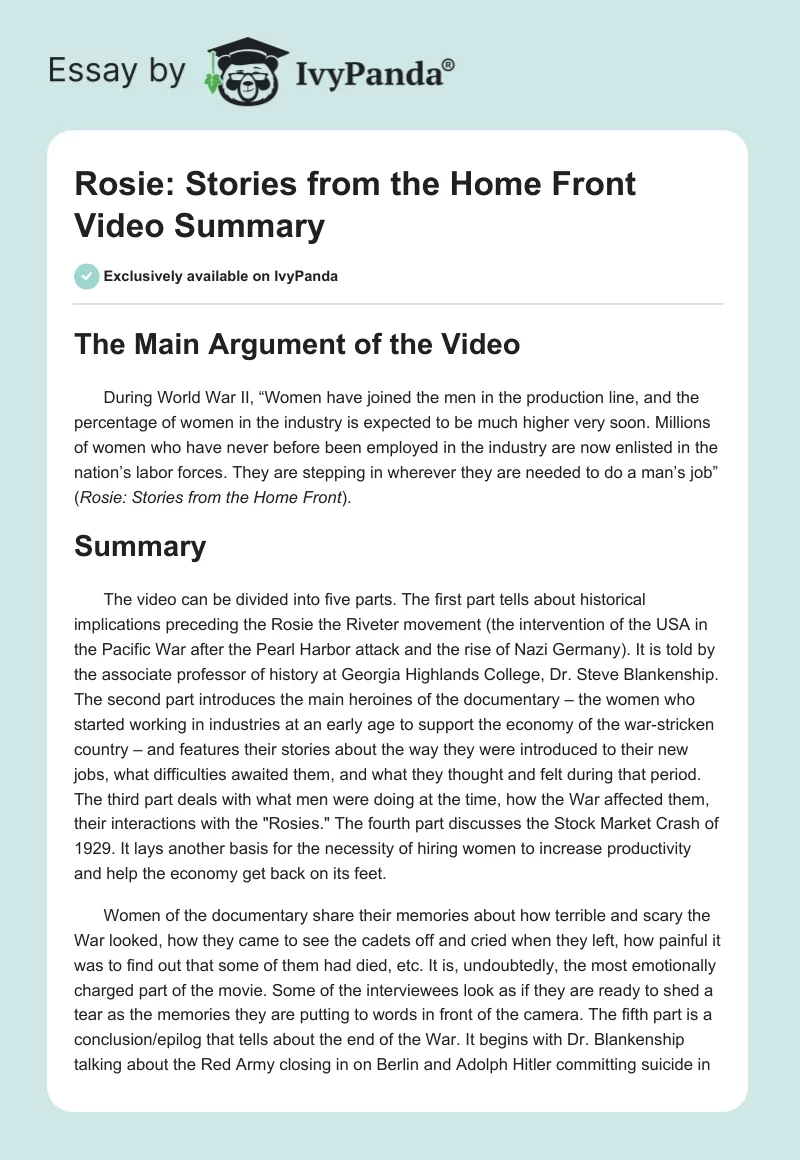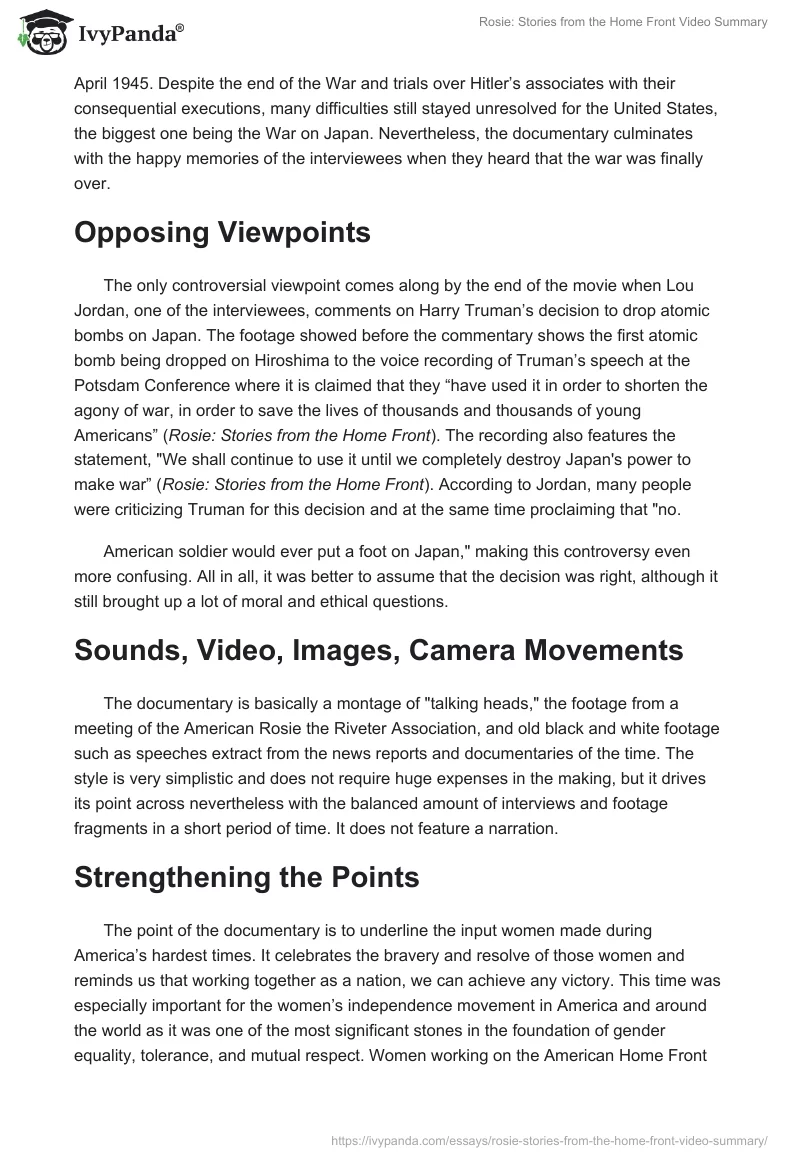The Main Argument of the Video
During World War II, “Women have joined the men in the production line, and the percentage of women in the industry is expected to be much higher very soon. Millions of women who have never before been employed in the industry are now enlisted in the nation’s labor forces. They are stepping in wherever they are needed to do a man’s job” (Rosie: Stories from the Home Front).
Summary
The video can be divided into five parts. The first part tells about historical implications preceding the Rosie the Riveter movement (the intervention of the USA in the Pacific War after the Pearl Harbor attack and the rise of Nazi Germany). It is told by the associate professor of history at Georgia Highlands College, Dr. Steve Blankenship. The second part introduces the main heroines of the documentary – the women who started working in industries at an early age to support the economy of the war-stricken country – and features their stories about the way they were introduced to their new jobs, what difficulties awaited them, and what they thought and felt during that period. The third part deals with what men were doing at the time, how the War affected them, their interactions with the “Rosies.” The fourth part discusses the Stock Market Crash of 1929. It lays another basis for the necessity of hiring women to increase productivity and help the economy get back on its feet.
Women of the documentary share their memories about how terrible and scary the War looked, how they came to see the cadets off and cried when they left, how painful it was to find out that some of them had died, etc. It is, undoubtedly, the most emotionally charged part of the movie. Some of the interviewees look as if they are ready to shed a tear as the memories they are putting to words in front of the camera. The fifth part is a conclusion/epilog that tells about the end of the War. It begins with Dr. Blankenship talking about the Red Army closing in on Berlin and Adolph Hitler committing suicide in April 1945. Despite the end of the War and trials over Hitler’s associates with their consequential executions, many difficulties still stayed unresolved for the United States, the biggest one being the War on Japan. Nevertheless, the documentary culminates with the happy memories of the interviewees when they heard that the war was finally over.
Opposing Viewpoints
The only controversial viewpoint comes along by the end of the movie when Lou Jordan, one of the interviewees, comments on Harry Truman’s decision to drop atomic bombs on Japan. The footage showed before the commentary shows the first atomic bomb being dropped on Hiroshima to the voice recording of Truman’s speech at the Potsdam Conference where it is claimed that they “have used it in order to shorten the agony of war, in order to save the lives of thousands and thousands of young Americans” (Rosie: Stories from the Home Front). The recording also features the statement, “We shall continue to use it until we completely destroy Japan’s power to make war” (Rosie: Stories from the Home Front). According to Jordan, many people were criticizing Truman for this decision and at the same time proclaiming that “no.
American soldier would ever put a foot on Japan,” making this controversy even more confusing. All in all, it was better to assume that the decision was right, although it still brought up a lot of moral and ethical questions.
Sounds, Video, Images, Camera Movements
The documentary is basically a montage of “talking heads,” the footage from a meeting of the American Rosie the Riveter Association, and old black and white footage such as speeches extract from the news reports and documentaries of the time. The style is very simplistic and does not require huge expenses in the making, but it drives its point across nevertheless with the balanced amount of interviews and footage fragments in a short period of time. It does not feature a narration.
Strengthening the Points
The point of the documentary is to underline the input women made during America’s hardest times. It celebrates the bravery and resolve of those women and reminds us that working together as a nation, we can achieve any victory. This time was especially important for the women’s independence movement in America and around the world as it was one of the most significant stones in the foundation of gender equality, tolerance, and mutual respect. Women working on the American Home Front provided war supplies and ammunition for men fighting overseas; their work in industries provided all the needed moral and practical support for those who were left in the country and did not join the draft. As the viewer hears the stories of ten “Rosies” who have agreed to participate in the film, he or she can vividly imagine the atmosphere of that time, which is also helped by documentary materials shown while they tell their stories. The feeling of the War being an atrocious, uncompromising disaster is conveyed perfectly well. The stories are touching; the old footage creates a necessary setting for a historical excursus.
Engagement
First of all, the video manages to unfold a story of a socially significant movement in thirty minutes without losing any vital points. It compresses the details but does not omit anything important. It does not require a long attention span, yet it gives the viewer enough information on the topic. The educational value of this video is medium, as it still feels like a summary of the period of time in question, but at least it gives the viewer a good overall image, which is a very important start for exploring the topic further. I would recommend this video to all people who want to get a quick understanding of what the “Rosie the Riveter” movement really is.
Questions
What would the men alongside whom the heroines worked comment?
What else could the heroines say about the continuing war on Japan and the Hiroshima and Nagasaki bombings?
Works Cited
Rosie: Stories from the Home Front. Ex. Prod. Brian S. Armstrong. Rome, Georgia: Exit Eleven Media. 2013. YouTube.


